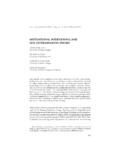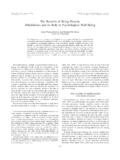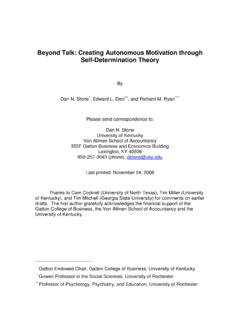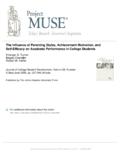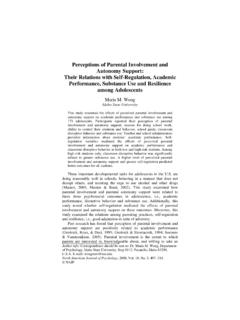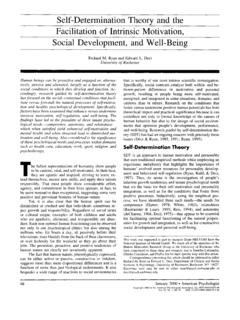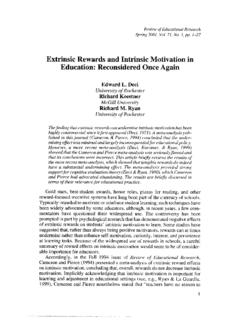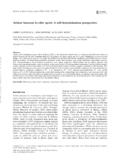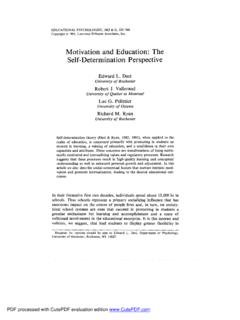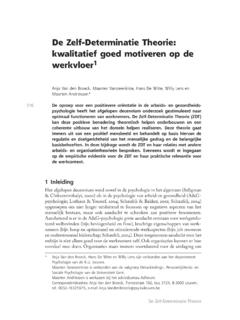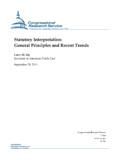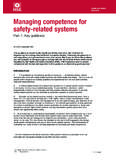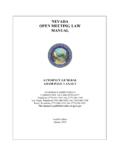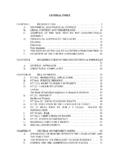Transcription of Capturing autonomy, competence, and re latedness at wo rk ...
1 Capturingautonomy, competence ,andrelatednessat work: Constructionandinitialvalidationof theWork-relatedBasicNeedSatisfactionscal eAnja Vanden Broeck1*, Maarten Vansteenkiste2,Hans De Witte1,BartSoenens2and Willy Lens11 University of Leuven, Belgium2 GhentUniversity,BelgiumThe satisfactionof the basic psychologicalneedsfor autonomy, competence ,andrelatedness,asdefinedinSel f-DeterminationTheory, hasbeenidentifiedasanimportantpredictor of individuals optimalfunctioningin variouslife studyofwork-relatedneed satisfactionseems,however,hamperedby the lack of assist futureresearch, the presentstudy aimedto develop and validateaWork-relatedBasic NeedSatisfactionscale (W-BNS).Usingfour Dutch-speakingsamples,evidencewas foundfor the three-factorstructureof thescale,the discriminantvalidity,and the reliabilityof the threeneed satisfactionsubscalesas well as theircriterion-relatedand W-BNS maytherefore be consideredasapromisingtool for futureresearch and scholarshavesuggestedthat needsare the fundamentaldeterminants ofhumanbehaviour (Latham&Pinder,2005).
2 Maslow (1943), forinstance,definedfivehierarchicallyord eredneeds ranging from (1965)formulated, amongothers,the needs forachievement,affiliation, and Theory (SDT;Deci&Ryan,2000;Vansteenkiste,Ryan,& Deci,2008)postulatesthreeinnatepsycholog icalneeds,whichhaveto be satisfiedforindividualsto flourish, that is, the needsforautonomy( ,experiencingasenseof volitionand psychologicalfreedom), competence ( , feelingeffective), and relatedness( , feeling lovedand caredfor).The empirical literature attestingto the beneficialeffectsof needsatisfactionasdefinedin SDT is growingexponentially,bothingeneral and in specificlife-domains(Deci&Ryan, 2008).The coherentdevelopmentof the literature of Occupationaland OrganizationalPsychology(2010), 83, 981 1002q2010 The British Psychological ,however,tobehampered by the lack of aspecific validated measure,leadingto the relianceonad hocscales( ,Roca &Gagne ,2008).Usingfour differentsamples,weaim to developand validateawork-relatedbasicneed satisfactionmeasure,whichmightfoster the studyof needsatisfactionin the psychologicalneed satisfaction in SDTC onceptualizationIn SDT,basic psychologicalneedsatisfactionis assumedto representthe underlyingmotivationalmechanismthat energizesand directspeople sbehaviour(Deci&Ryan,2000).
3 Psychologicalneedsatisfactionis regardedas the essential nutrimentforindividuals optimal functioningand well-being,as water,minerals, and sunshineareessential forplants to bloom(Deci&Ryan,2000; Ryan,1995).In SDT,threebasic needsare distinguished:the needs forautonomy, competence ,and ,the needforautonomy representsindividuals inherent desireto feel volitionaland to experienceasense of choiceand psychologicalfreedom whencarrying out anactivity(deCharms, 1968;Deci&Ryan, 2000).Although related,SDT sconceptofautonomy is somewhatdifferentfrom the conceptualizationsof autonomy typicallyheldin organizationalpsychology( , Morgeson&Humphrey, 2006).Karasek (1979), forinstance, equated autonomy withdecision latitudeand controlover skill Oldham(1976) definedautonomy in terms of substantialfreedom,independenceand discretionto the individualin schedulingthe workand indeterminingthe proceduresto be usedin carrying it out (p. 258).First, unlikeSDTwhichreferstothe subjectiveexperienceof psychologicalfreedomand choiceduringactivityengagement,thesedefi nitions refer to autonomyas atask characteristic.
4 Second,althoughautonomy as atask characteristic is likelyto contributeto feelingsofpsychologicalfreedom,peoplemig htalso experienceautonomysatisfactionwhentheyde pendonothersand evenwhen theyfollowothers requests. Employeesmight,forinstance, follow-uparequestfrom theirsupervisor(and thus fail to be independent)but nonethelessact willinglybecausetheirsupervisorprovidedt hemameaningfulrationalefor doingso (Soenenset al.,2007).Second, the needforcompetenceis definedas individuals inherentdesire to feeleffectiveininteracting with the environment(Deci &Ryan,2000; White,1959). It isprominent in the propensity to exploreand manipulate the environmentand to engagein challengingtasksto test and extendone to adaptto complexand changingenvironments,whereas competencefrustration is likelyto resultin helplessnessand alack of motivation (Deci&Ryan,2000).The needfor competenceis ratheruncontroversial in organizational figurein Vroom s (1964)Expectancy-Value Theoryand Bandura s(1997)Self-EfficacyTheory, althoughsomedifferences deservebeing ,outcomeexpectancies and self-efficacyrepresentacquired cognitionswithrespectto one scapacitiesto are therefore positivelyvaluedas far as theyhelpone in needforcompetence,on the otherhand,representsaninbornneed.
5 Competencesatisfactionrefersto amoregeneral,affectiveexperience of effectivenesswhich resultsfrommastering differencesbetweenself-efficacy andthe needforcompetence,both are likelyto be correlatedat the empirical , the need forrelatednessisdefinedas individuals inherentpropensitytofeel connectedto others, that is, to be amember of agroup, to love and care and be982 Anja Vanden cared for(Baumeister &Leary, 1995).The needforrelatednessissatisfiedwhenpeoplee xperienceasenseof communionand developcloseand intimaterelationships with others(Deci&Ryan,2000).The assumption that individuals have thenaturaltendencyto integratethemselvesin the socialmatrix and benefit frombeingcaredforisequally emphasizedin developmentalapproachessuchas AttachmentTheory(Bowlby,1969).It is consistent withconceptsin organizationalpsychologysuchas socialsupport(Viswesvaran, Sanchez,&Fisher, 1999)and lonelinessatwork(Wright, Burt, &Strongman, 2006).Characteristics of the basicpsychological needsThe SDT viewon the basicpsychologicalneeds differs in severalwaysfromotherwell-knownneedperspe ctives ( ,Maslow,1943; McClelland, 1965).
6 First,Maslowconsidershumanneeds to behierarchically ordered:higherorderneeds only becomeprominent whenlowerorderneedsare sufficientlysatisfied. In contrast, SDT does notpostulate aparticular orderin whichthe threeneedshave to be met. Instead,allthreeneedsare considered important forindividuals ,McClellandconsidersneeds to beacquiredthrough learning or socialization: individuals who arelaudedafterachievingaparticulargoal learntoattachpositive feelingsto achievementsituations and,asaresult, developastrongneed forachievement(Winterbottom,1959).Rather thanlearned,SDT considersthe basicpsychologicalneeds to beinnate,fundamentalpropensities,much like biological needs (Deci&Ryan, 2000).SDT hereinalignswith Baumeisterand Leary(1995)and White (1959).Althoughindividuals fromdifferentagegroupsand differentculturesmay expressand satisfytheirbasicpsychologicalneeds in differentways, everybodyis thuslikelyto benefit fromhavingthe basicpsychologicalneeds line withthis claim,various studieshaveprovided evidence forthe importanceof need satisfactionin various agegroups( ,Soenenset al.)
7 ,2007) and in culturallyvery diversesamples( , Deciet al.,2001;Vansteenkiste,Lens,Soenens,&Luy ckx, 2006).Third,as McClelland focusesupon differencesin needstrengthor the importanceindividuals attach to particular needs, he assumes,forinstance,that individualswith ahighneedforachievementare morestronglymotivatedin achievement situationscomparedto individuals with alow needforachievement. In contrast, SDT does notfocus uponindividualdifferencesin needstrength, but considersthe degreeto whichpeopleare able tosatisfytheirfundamentalneeds as the mostimportant predictorforoptimal functioning(Deci&Ryan,2000).Consequently ,SDT maintainsthat, forinstance, positivelyperceived feedback is beneficial forall employeesas it satisfiestheirinbornneedfor competence (Mouratidis,Vansteenkiste,Lens ,&Sideridis, 2008).Finally, bothMaslowand to Maslow,particularneedsbecomelesspotentwh entheyare reasonablywell ,McClellandassumes that aparticularneed drives behaviouruntilsufficient needsatisfactionis ,the behaviouris stopped until the needbecomes salient instance,peoplewith ahigh needforaffiliationwill searchforwarmsocial contacts.
8 Oncesuch contacthas taken place,the needis temporarilyreducedand the behaviourwanes. According to SDT,individualsdo not needtoexperienceadeficitforthe needsto fuel behaviour. Rather,individualsare attractedtosituations in their needsare satisfied,theyarelikelyto feel energizedand to activelyengageinsubsequentneed fulfillingactivities(Deci&Ryan,2000).Nee d satisfaction at work983 SDT sempirical basisConsistentwithSDT,severalstudieshav eshownpositive relationsbetweenneedsatisfactionand optimal functioning,both at the interpersonal and intra-individuallevel( ,Mouratidiset al.,2008; Reis, Sheldon, Gable, Roscoe, &Ryan, 2000) and in general(Sheldon, Elliot, Kim, &Kasser,2001) as well as acrossdifferentlife-domains (see Deci &Ryan,2008, foranoverview). In the context of work, initial evidence was found forpositiverelationsbetweenacomposite scoreof need satisfaction( , aggregatedacrossthe threeneeds)and employees work-relatedwell-being( , job satisfaction, workengagement,and lowerburnout),favourableattitudes ( ,decreasedturnover-intentions, increasedreadiness to change), and higherperformance(seeGagne &Deci,2005;Vanden Broeck,Vansteenkiste,&DeWitte, 2008,foroverviews).
9 Work-relatedneedsatisfactionhas furthermore beenrelatedto increasedgeneral well-beingandto less ill-being( ,Baard,Deci,&Ryan,2004).Finally, studiesin whichthe threeneedswereexamined separatelyshowedthat eachof the threeneeds correlatedpositivelywith employees optimalfunctioning( ,Lynch,Plant,&Ryan, 2005),whichis consistentwithSDT sclaim that the satisfactionof eachof the threebasicneedscontributesto individuals flourishing(Deci&Ryan,2000).Satisfaction of the threeneedsmay,however,relatedifferently to controlledmotivation. Accordingto SDT,controlledmotivationresultsfrom experiencingexternal( , abonus,supervisoryapproval)or internal ( , guilt,shame) autonomousmotivation, whichisprominent whenemployeesengageinanactivitybecauseth eyconsider it personallyvaluableor intrinsicallyinteresting(Deci&Ryan,2000) . Autonomousmotivation corre-latespositivelywith, forinstance,work-related well-beingand optimalperformanceas it is conduciveto the satisfactionof the threebasicneeds(Gagne &Deci, 2005;Vanden Broeck, Vansteenkiste,&DeWitte, 2008).
10 When employeesfeel controlled, incontrast, their need forautonomy is clearlyforestalled (Deci &Ryan,2000).Employees,whoare, forinstance,forcedto meetadeadline,will experience littlevolitioninexecutingthe task. Despitethis pressure, theymight, however,manage to satisfytheirneedsforcompetenceand relatednessby accomplishingthe assignedtask or byreceiving socialsupportfrom others. Suchsatisfactionis, however,not guaranteed asfeeling pressured to engageinaworkactivity is not necessarily accompanied by feelingsof effectivenessand interpersonalconnection (Markland&Tobin,2010).Apartfrom relatingtoemployees optimalfunctioning,basicneed satisfactionis alsousefulto understandthe motivating impactof supervisors leadership styles( , Deciet al.,2001) and job characteristics(Van den Broeck,Vansteenkiste,&DeWitte, 2008),and their relationships with employees well-beingand researchClearly,the construct of basicneedsatisfactionmaybeusefulto gain insight inemployees functioningand to examinethe motivational potential of promisingbodyof research, however,differentad are the basicneed satisfactionat work scale(Baardet al.)
